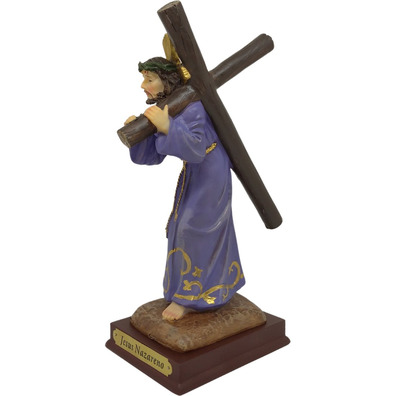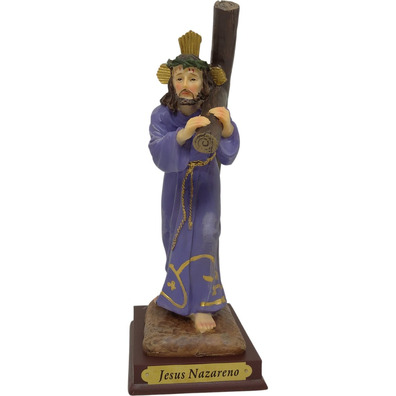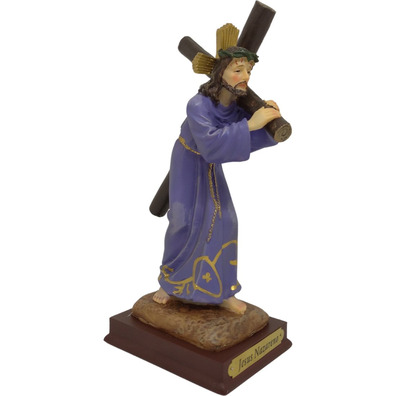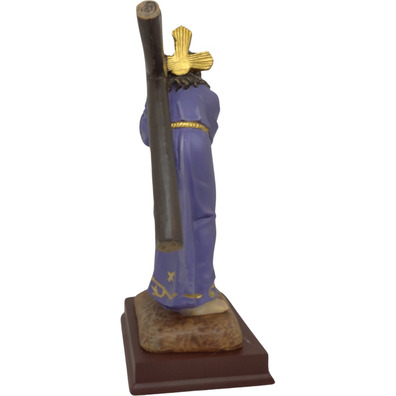Christ the Nazarene low-cost figurines
15,00€
Taxes includedCatholic product in stock. Products ready to be shipped. You can check the approximate delivery time during the purchase process.
Christ the Nazarene low-cost figurines
- Our Father Jesus the Nazarene figurine.
- Made of marmoline.
- Religious image of 21 cm (8.27 in) in height.
- 18.5 cm (7.28 in) in height, excluding the base and the halos.
- Base of 9.5 x 7.5 cm.
- The purchase price includes:
- Golden halos and a crown of thorns made of marmoline.
- A marmoline cross imitating wood.
- Polychrome painting. Purple tunic with golden details imitating embroidery.
- Base with the name Jesus the Nazarene.
- Other Jesus the Nazarene figurines are available for purchase.
Origin of the Figures of Jesus the Nazarene
Statues, stained-glass windows, paintings, and other artistic depictions of biblical passages have been used since early Christianity to illustrate the teachings of the Word of Jesus.
During the Middle Ages, figures and statues began to be taken out of temples. This marked the origin of what we now know as the Holy Week processions. Statues representing key moments of the Passion, Death, and Resurrection of Christ were used as a means of evangelization, providing a graphic explanation of the mysteries of Jesus' life to a largely illiterate population.
In Spain, these images reached their peak relevance between the 16th and 17th centuries, thanks to artists like Juan de Mesa, whose sculptures continue to be objects of great devotion.
Figures of Jesus the Nazarene represent Christ carrying the cross, a key moment of the Passion. The figure of Christ the Nazarene, also known as Our Father Jesus the Nazarene, conveys to the faithful the message of humility and submission to the Word of God. Jesus accepts his fate and carries the cross to save all humanity from its sins. Our Lord gives his life for all of us.
Holy Week Images of Christ the Nazarene
Several cities in Spain house iconic images of Jesus the Nazarene, known for their deep devotion and beauty. Among the most renowned are:
- Jesus of the Great Power (Seville): Known for its serenity and visual impact, it is one of the most revered figures in Spain.
- Jesus the Nazarene of Cádiz: A religious icon that attracts thousands of devotees during the city's Holy Week processions.
- Our Father Jesus the Nazarene (Vélez-Málaga): Stands out for its rich artistic and spiritual expression.
- Christ the Nazarene of Pobra do Caramiñal (Galicia): A beloved figure in Galicia, with highly recognized processions.
What is the Color of the Tunic of the Figures of Jesus the Nazarene?
Holy Week figures, despite depicting moments from the Bible, have their own characteristics depending on the idiosyncrasies of each region. Thus, images of Christ the Nazarene share fundamental features that identify them (the tunic, the cross on his back, the crown of thorns, etc.), but their specific details vary based on their place of origin, making each statue unique.
Among the common elements that distinguish Nazarene figures is, of course, the tunic.
Tunic garments are usually made of a single piece of fabric, featuring one solid color and decorated with embroidery or appliqués.
The most common colors for Nazarene tunics are purple or black. Both shades are liturgical colors associated with Good Friday, the day when Jesus the Nazarene processions often take place.
Colors and procession dates may vary depending on the region.
What Are the Holy Week Nazarenes?
So far, we have been talking about Jesus the Nazarene.
The Holy Week Nazarenes take their name from this type of religious sculpture. Generally, the term "Nazarenes" refers to members of a brotherhood or fraternity who participate in Holy Week processions.
Their primary purpose is to carry out acts of penance, following strict rules regarding attire and behavior.
Nazarenes, also known as brotherhood members, typically wear a tunic, a pointed hood, a cincture, and wax candles. The color and design of these garments vary depending on the region and the brotherhood. Each fraternity has statutes that define the basic rules of conduct, including the attire that members must wear during processions and other ceremonial outings.










